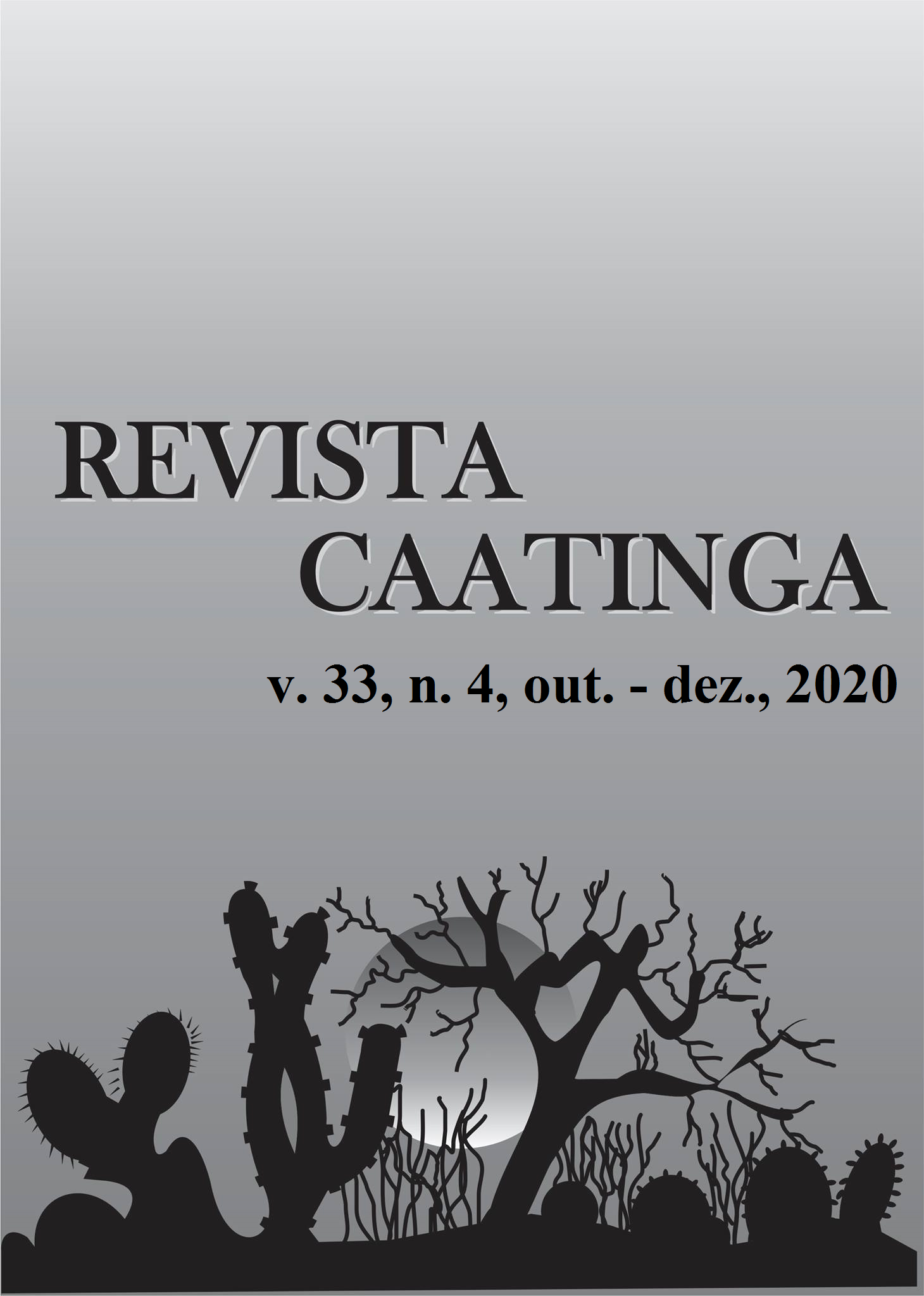SEED DISPERSAL, SEEDBANK, SEEDLING SURVIVAL, AND INITIAL GROWTH OF THREE CAATINGA TREES
DOI:
https://doi.org/10.1590/1983-21252020v33n416rcKeywords:
Natural regeneration. Aroeira. Ipê roxo. Cumarú. Seedling emergence.Abstract
Myracrodruon urundeuva, Handroanthus impetiginosus and Amburana cearensis are Caatinga tree species that produce valuable timber, but little is known about their ecology. The objective of this study was to evaluate the seed distribution of these species on the forest floor before and after seed dispersal; and seedling emergence, survival, and growth during the rainy season after dispersal of seeds. There were no remaining viable seeds of these species in the seedbank before seed dispersal. The average numbers of seeds after seed dispersal were 188 seed m-2 in a 30 m radius around M. urundeuva, 9 seed m-2 in a 10 m radius around H. impetiginosus, and 5 seed m-2 in a 20 m radius around A. cearensis. The distance of seed dispersal reached 30, 20, and 10 m for M. urundeuva, H. impetiginosus, and A. cearensis trees, respectively, due to differences in tree height, seed weight, forest density, and wind intensity. Seedling emergence was observed during 4 (M. urundeuva) and 9 (H. impetiginosus and A. cearensis) weeks. High mortality predominated at the beginning and end of the rainy season for M. urundeuva and A. cearensis, respectively, while practically all H. impetiginosus seedlings survived. M. urundeuva showed the highest mortality but had higher number of established seedlings than the other species. Seedling survival peaked around 5 m from the tree base. Seedling recruitment and natural regeneration of these trees are assured in the Caatinga site evaluated.
Downloads
References
BASKIN, C. C.; BASKIN, J. M. Seeds: ecology, biogeography, and evolution of dormancy and germination. 1. ed. New York, NY: Academic Press, 1998. 666 p.
BRASIL. Ministério do Meio Ambiente. IBAMA - Reconhece a Reserva Particular do Patrimônio Natural da Fazenda Tamanduá, em Santa Terezinha – PB, [1998]. Disponível em: <https://pesquisa.in.gov.br/imprensa/jsp/visualiza/index.jsp?data=31/07/1998&jornal=1&pagina=139&totalArquivos=152>. Acesso em: 20 ago. 2020.
BRITO, L. B. M.; ARAÚJO, F. S. Banco de sementes de Cordia oncocalyx Allemão em uma área de Caatinga sobre planossolo. Revista Caatinga, 22: 206-212, 2009.
COSTA, R. C.; ARAÚJO, F. S. Densidade, germinação e flora do banco de sementes do solo no final da estação seca em uma área de Caatinga, Quixadá, CE. Acta Botânica Brasílica, 17: 259-264, 2003.
FERNANDES, M. F.; QUEIROZ, L. P. Vegetação e flora da Caatinga, Ciência e Cultura, 70: 51-56, 2018.
GOMES, V. G. N.; QUIRINO, Z. G. M. Síndromes de dispersão de espécies vegetais no Cariri Paraibano. Revista Brasileira de Geografia Física, 9: 1157-1167, 2016.
LIMA, V. V. F. et al. Germinação de espécies arbóreas de floresta estacional decidual do vale do rio Paranã em Goiás após três tipos de armazenamento por até 15 meses. Biota Neotropica, 8: 89-97, 2008.
LÚCIO, A. M. F. N.; SILVA, G. H.; LOPES, I. S. Influência da época de coleta e armazenamento na qualidade fisiológica da semente de cumarú. Engenharia Ambiental, 7: 48-56, 2010.
MARTINELLI, G.; MORAES, M. A. (Orgs.) Livro vermelho da flora do Brasil. 1. ed. Rio de Janeiro, RJ: Andrea Jakobson: Instituto de Pesquisas Jardim Botânico do Rio de Janeiro, 2013. 1100 p.
MEIADO, M. V. Banco de sementes no solo da Caatinga, uma Floresta Tropical Seca no Nordeste do Brasil. Informativo ABRATES, 24: 39-43, 2014.
PAGLIARINI, M. K. et al. Influência do tamanho de sementes e substratos na germinação e biometria de plântulas de jatobá. Tecnologia & Ciência Agropecuária, 8: 33-38, 2014.
PARAÍBA. Agência Executiva de Gestão das Águas do Estado da Paraíba. Meteorologia: monitoramento mensal das chuvas por município. Disponível em: http://www.aesa.pb.gov.br/aesa-website/. Acesso em: 25 fev. 2010.
SANTOS, C. A. et al. Germinação de sementes de duas espécies da caatinga sob déficit hídrico e salinidade. Pesquisa Florestal Brasileira, 36: 219-224, 2016.
SILVA, M. C. N. A.; RODAL, M. J. N. Padrões das síndromes de dispersão de plantas em áreas com diferentes graus de pluviosidade, PE, Brasil. Acta Botânica Brasílica, 23: 1040-1047, 2009.
SIQUEIRA FILHO, J. A. et al. Guia de campo de árvores da Caatinga. 1. ed. Petrolina, PE: Editora e Gráfica Franciscana Ltda, 2009. 64 p.
WANG, R. et al. Distance-dependent seed‒seedling transition in the tree Castanopsis sclerophylla is altered by fragment size. Communications Biology: 2: 277-287, 2019.
Downloads
Published
Issue
Section
License
Os Autores que publicam na Revista Caatinga concordam com os seguintes termos:
a) Os Autores mantêm os direitos autorais e concedem à revista o direito de primeira publicação, com o trabalho simultaneamente licenciado sob a Licença Creative Commons do tipo atribuição CC-BY, para todo o conteúdo do periódico, exceto onde estiver identificado, que permite o compartilhamento do trabalho com reconhecimento da autoria e publicação inicial nesta revista, sem fins comerciais.
b) Os Autores têm autorização para distribuição não-exclusiva da versão do trabalho publicada nesta revista (ex.: publicar em repositório institucional ou como capítulo de livro), com reconhecimento de autoria e publicação inicial nesta revista.
c) Os Autores têm permissão e são estimulados a publicar e distribuir seu trabalho online (ex.: em repositórios institucionais ou na sua página pessoal) a qualquer ponto antes ou durante o processo editorial, já que isso pode gerar alterações produtivas, bem como aumentar o impacto e a citação do trabalho publicado (Veja O Efeito do Acesso Livre).







